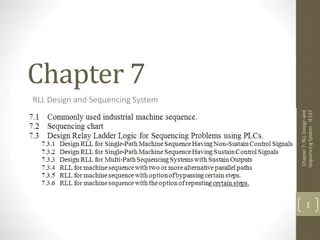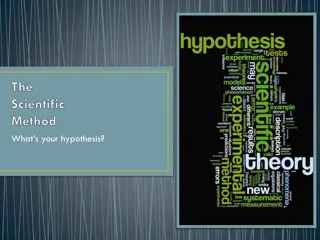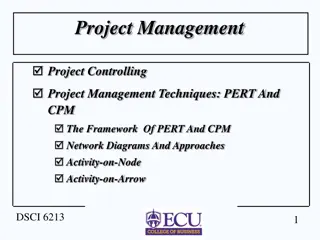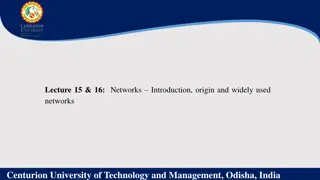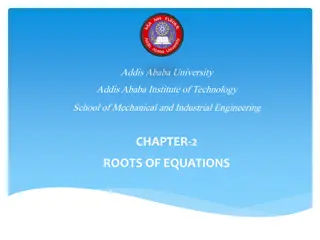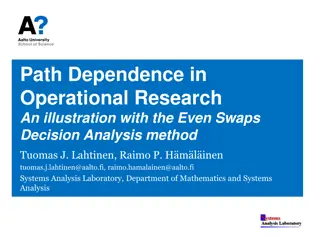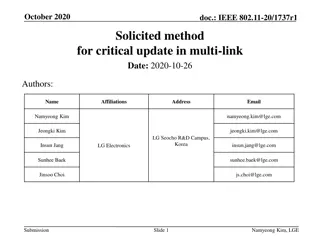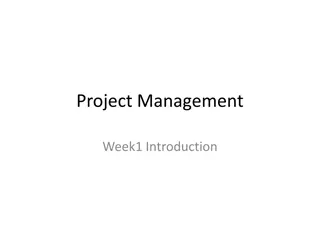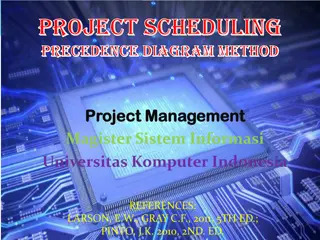Critical Path Method in Project Management
Critical Path Method (CPM) is a vital tool in project management for determining the longest sequence of tasks essential to complete a project within a specified timeframe. This method helps project managers identify tasks critical to project completion and allows for efficient scheduling and resource allocation. By calculating Early Start (ES), Early Finish (EF), Late Start (LS), and Late Finish (LF) times for each activity, project teams can pinpoint the project's critical path and potential areas for optimization. Understanding these concepts is crucial for effective project planning and execution.
Download Presentation

Please find below an Image/Link to download the presentation.
The content on the website is provided AS IS for your information and personal use only. It may not be sold, licensed, or shared on other websites without obtaining consent from the author.If you encounter any issues during the download, it is possible that the publisher has removed the file from their server.
You are allowed to download the files provided on this website for personal or commercial use, subject to the condition that they are used lawfully. All files are the property of their respective owners.
The content on the website is provided AS IS for your information and personal use only. It may not be sold, licensed, or shared on other websites without obtaining consent from the author.
E N D
Presentation Transcript
WELCOME TO LECTURE 6 SELESTIAN AUGUSTINO
Try this question now: Draw a network diagram Immediate predecessor activity - Activity A B A C, D B E C F D G E, F
3.1.11 Critical Path Method ES, EF, LS, LF, FLOATS Early Start-ES Early Start or ES is the earliest time that activity can start. An activity near the end of path or much later will only start if all the previous activities in the path also started early. If any one of the previous activities slips then it will push this activity out. Early Finish-EF Early Finish or EF is the earliest time that activity can finish. It is the date that an activity can finish if all previous activities started early and none of the activities slipped. If project manager and team knows about early start and early finish dates of all the activities(tasks) then they will know how much freedom they have to move the start dates without causing any problem to the project.
Tips for calculation of ES, EF during forward pass Forward pass is the direction from left to right as you traverse on network diagram. ES of first activity = 1 ES of all other activities = EF(of previous activity) + 1 If two activities say A and B converge (i.e. merge) to one activity, say C in forward pass, then ES of activity C = (greater EF from activity A and B) + 1 EF = ES + duration -1
Late Start-LS Late Start or LS is the latest time an activity can start. If an activity is on the path which is much shorter compare to critical path, then it can start much late without any delay to the project. Late Finish-LF Late Finish or LF is the latest time that an activity can finish. If an activity is on a shorter path and all of the other activities on same path start as well as finish early, then it can finish very late without causing project to be late. Knowing late start and late finish will help you see how much it can be played around in the schedule. If an activity has large LS and LF means there are more options available.
Tips for calculation of LS, LF during reverse pass Reverse/Backward pass is the direction from right to left as you traverse on network diagram. LF of last activity = EF of the same last activity For all other activities except the convergence mentioned in the next line, LF = LS(of previous activity) -1 If two activities say A and B converge (i.e. merge) to one activity in the reverse pass say C then, LF(of activity C) = (Lesser LS from activity A and B) -1 LS = LF - duration +1
Problem 3: The following data are available for construction project. a) Construct a network diagram b) Calculate the project completion time c) Find the critical path and critical activities d) Determine the ES, EF, LS, LF and TF of each activity Immediate predecessor activity Activity duration (weeks) Activity A B C D E F - A A B C D,E 3 5 7 10 5 4
Floats Float / Slack is the amount of time an activity or project can be delayed from the early start without changing the completion date of the project. Types of float 1.Total Float (TF) The amount of time that an activity can be delayed or extended from its early start date without delaying the project finish date or violating a schedule constraint. Mathematically: Late Finish Early Finish = Total Float 2. Free Float (FF) The amount of time that an activity can be delayed without delaying the early start date of any successor or violating a schedule constraint. Mathematically: Earliest Successors Early Start Activity s Early Finish = Free Float
Floats 3. Interfering Float (INTF) The amount of time that an activity can be delayed or extended from its early start date without delaying the project finish date, but delaying an activity into interfering float will delay the start of one or more following non-critical activities. If an activity is delayed for the amount of the Free and Interfering Float, its successor activities are critical. Mathematically: Total Float Free Float = Interfering Float 4. Independent Float (INDF) The maximum amount of time an activity can be delayed without delaying the early start of the succeeding activities and without being affected by the allowable delay of any predecessor activity. Mathematically: Predecessors Late Finish Activity s duration = Independent Float Remark: when the result is a negative value, we set the value to zero.
Advantages of CPM The CPM makes it easier for the project managers to build a team and create human network for efficient handling of a multi-tasked project. The Critical Path Method binds the entire team together and motivates the human resources in timely completion of the tasks in a project. The CPM takes into consideration the requirements well in advance to complete a project in the most efficient way possible. With help of the Critical Path Method the project managers can determine the duration and estimate exact time and cost of the project. It helps to monitor human resources, and the direct and indirect costs associated with the project. The CPM assists the project managers in planning schedules, monitoring tasks, and helps control the project expenses. The Critical Path Method also makes it convenient for the project managers to calculate the time required to complete the tasks of the project. That helps them to predict completion date of every phase, anticipate problems along the way, if any, and react accordingly.
Disadvantages of CPM In a big project, a CPM can become extremely complicated and difficult to fathom for the new recruits to the project team. If the project is far too bulky and lengthy, the Critical Path Method requires software to monitor the plan. CPM can become ineffective and difficult to manage if it is not well-defined and stable. It cannot effectively handle sudden changes in the implementation of the plan on ground. It is very difficult to redraw the entire CPM chart if the plan of the project suddenly changes midway. The Critical Path Method cannot form and control the schedules of the persons involved in the project. The allocation of resources cannot be properly monitored. The critical path of the CPM of a big project is not always clear. The project managers have to spend a lot of time to calculate it carefully. The Critical Path Method takes longer to identity and to monitor the critical path when the project is of big dimension.
Using CPM, identifying and determining a critical path is difficult when there are many other similar duration paths in the project. At times, to design a CPM is time consuming. It is also difficult to estimate the activity completion time in a multidimensional project. Self study 1. Enumerate the concrete significance of CPM (At least 4 points).
3.1.12 Time Estimation in PERT (With Calculation) There are three different estimates of activity duration in PERT: 1. Optimistic time 2. Pessimistic time 3. Most Likely time 1. Optimistic time, expressed as to , represents estimate of minimum possible time by which an activity can be completed assuming that everything is in order according to the plan and there can be only minimum amount of difficulty. 2. Pessimistic time, expressed as tp represents estimate of maximum possible time by which an activity can be completed assuming that things may not be in accordance with the plan and there can be incidence of difficulties in carrying out the activity. 3. Most Likely time, expressed as tm , represents estimate of time for completion of an activity, which is neither optimistic nor pessimistic, assuming that things should go in a normal way, and if the activity is repeated several times, in most of the cases, it will be completed in time represented by t.
From the above three different time estimates, PERT suggests to work out the following; The expected time, expressed as (te) which is the average of to, tpand tmcalculated as, te= (to+ 4tm+ tp) / 6 The variance expressed as (Var.) , calculated as, Var.= ((tp-to)/6) The standard deviation expressed as ,which is the square root of variance (Var.) calculated as, = (Var.) = ((tp-to)/6) = (tp-to)/6
Problem 4: Using the tabulated schedules below, a) Draw the PERT network diagram b) Calculate the expected time, variance and standard deviation of each activity c) Draw the CPM network diagram d) Calculate the project completion time e) Find the critical path f) Identify the critical activities
Self study 1. What are the advantages and disadvantages of PERT? (At least 5 points @)
3.2.0 Resource Management Resource is a stock or supply of money, materials, staff, and other assets that can be drawn on by a person or organization in order to function effectively. Resource management is the process of planning, scheduling, and allocating resources in the best possible way. The ultimate aim is to maximize the resources efficiency. This means, it ensures that internal and external resources are used effectively on time and to budget. OR Resource management is the process of planning the resources necessary to meet the objectives of the project, and to satisfy the client s requirements. OR Resource management is the efficient and effective development of an organization's resources when they are needed. Example: Financial resources, inventory, human skills, production resources, or information technology (IT) and natural resources. OR Resource management is acquiring, allocating and managing the resources, such as individuals and their skills, finances, technology, materials, machinery and natural resources required for a project.
3.2.1 Need for resource management Resource management is needed because: It provides the overview of everyone and everything involved in the project It enables utilization planning It makes the planning and management process more transparent It help you to see problems before they start It gives control over the project Techniques used in resource management are: 1. Resource Levelling 2. Resource Allocation 3. Resource Forecasting
3.2.2 Basic important types of resources in construction projects 1. Human resource 2. Financial resource 3. Material resource 4. Machinery resource
1. Human resource No matter the size and complexity of the project, in order for the project tasks to be performed effectively, human resources are essential. Human resources are considered to have the most complex requirements than the other two types of project resources. Therefore, project managers should plan in advance and identify potential people to become part of the project team by making sure they are available and skilled for the project in question. Normally a project team is a group of people that is managed by a project manager. The team management part is often the hardest part of the project, especially if the manager hasn t had to lead a team in the past. Managing the project team s time and workload can be tricky too, as, usually, most of the project team members don t work solely on one project. They often have day jobs and may be involved in other projects at the same time.
1. Human resource If you, as a project manager, know what individuals you need for your project it could be a lot easier to do your resource planning, which should help you balance those peaks and troughs of availability in the team. Spend some time thinking through the different skill sets that you need and the kind of tasks that are required for the project, regardless of the project complexity and type. Even at this early stage, you can still get a good idea of who needs to be involved. You ll have to work out who is needed on the project at what times, based on your project schedule. You ll need to bring in different types of subject matter experts at different times, and each one will have to know enough about the project s objectives to get their part done successfully.
2. Financial resource (Capital or Cost Resource) The second essential resource for successful project completion is capital. As you know, all projects, regardless of their type, scale or complexity, need money. The cost resources are used for many things related to the project, including project team members salaries, cost of tools and equipment that you and your team will be using during the project execution. Generally, managing a budget for a particular project is one of the core skills that all project managers must have. As a project manager you need to be confident handling finances and costs so that every phase of the project goes smoothly. One important aspect of this type of resource is for the project manager to talk to its project sponsors about their expectations for the money that are planned to be spent. It s important that project sponsors have a realistic idea about how much the project will cost, and as a project manager you can help them do that once you have undertaken some of the planning.
2. Financial resource (Capital or Cost Resource) If you don t have enough finances for your project then you won t be able to get everything done. It s that simple: the budget funds the work and when it runs out the work has to stop. If they want the project to be completed successfully then it needs to be adequately funded. You ll need to know how much money you are spending because it helps you establish whether you are on track or not.
3. Material resources Projects also use up material resources that include different materials, supplies and/or items that are part of the project. Assets, or goods, vary from project to project but it s highly likely that your project will need some kind of tangible resource. It s normally what you use the project budget to buy. Equipment or machinery (which you might hire for the life of the project or buy). Property (again, it might be something you hire for the project such as a temporary cabin on a building site). Project managers can also make use of assets that the company already has although they may have to budget for borrowing them or schedule in the right time to use them so that they don t clash with another project. An example might be a testing lab that is used for multiple projects and that you will need to book in advance in order not to coincide with other project teams using the resource. This type of resource is particularly important to be planned in advance because otherwise you can encounter huge problems for your project.
3.2.3 Resource planning 1. What is resource planning? Resource planning is a specific area in project management that deals with gathering and making use of all the necessary resources required to deliver a project. In this respect, anything can be viewed as a resource: people, equipment, materials and facilities. Resource planning is also about managing available talent. It allows project managers to make sure that one person will be working on one thing, at one time, for a specific project. Managing resources is also about matching skill level to task difficulty level. This way, team members get to do challenging work and stay motivated.
2. Why is resource planning important in project management? Resources can make or break your project. Without the right resources, they won t turn into reality. Strategic use of resources allow project managers to ship on time, respecting deadlines and costs. To this end, resource planning is an essential step. Priorities can change on the fly. In order to accommodate changes, project managers need to keep an eye on resource availability and utilization so they can shift resources when needed. It keeps an eye on utilization rates. This is very important if you charge clients according to the number of hours. It can help project managers to create balance and a good mood inside their team. Matching tasks and skill set will keep team members happy and engaged. Also, by constantly managing individual availability, project managers make sure that work is divided equally and that no one gets overworked.
3.2.4 Resource levelling Resource levelling is a technique in project management that overlooks resource allocation and resolves possible conflict arising from over- allocation. When project managers undertake a project, they need to plan their resources accordingly. This will benefit the organization without having to face conflicts and not being able to deliver on time. Resource levelling is considered one of the key elements to resource management in the organization. OR Resource levelling is a project management technique in which the demand for limited resources is accommodated by adjusting the project program. In construction, resource levelling can be used to analyse the variations in resource usage that can occur over time, and which can be inefficient and costly.
3.2.4 Resource levelling Resource levelling is a technique in which start and finish dates are adjusted based on resource constraints with the goal of balancing demand for resources with the available supply. OR Resource levelling is a PM technique s which is begins and ends dates is adjusted depends on resource restraints to the objectives of balance the requirements for resources with presented supply. OR Resource levelling is a technique in project management that overlooks resource allocation and resolves possible conflict arising from over- allocation. When project managers undertake a project, they need to plan their resources accordingly OR
3.2.5 Objectives of resource levelling To allocate resource efficiently, so that the project can be completed in the given time period To overcome staff level constraints To maximize the utilisation of resources between project
3.2.6 Project crashing Project crashing is the process by which duration of project is reduced by increasing the amount of resources allocated. It can be used in the management of construction works when the program is running behind schedule. It is important to note that crashing is done only to critical activities. This can be achieved by any one of the following approaches: 1) Addressing productivity issues of the current resources and making them more efficient. This can be done by taking better care of resources available and cutting cost and time wherever possible. 2) Bringing in new additional resources to speed up the processes. 3) By evaluating alternatives available and analysing them in order to find which one will help in compressing the duration with lowest cost.
3.2.6 Project crashing Risks of Project Crashing in Project Management (PM) 1) Various external and internal factors may lead project manager to go for crashing but it usually affects the quality of work as the time taken (besides cost) is the major issue on his mind. 2) Using additional resources does not always guarantee better results. Example if an organisation decides to hire more employees or outsource them, one can't be sure that they are trained enough to deliver as per expected standards which one will help in compressing the duration with lowest cost.
3.2.7Need for crashing Project crashing can be necessary when: The program planning has been inaccurate When there have been unforeseen events which have caused delays, such as defects being discovered. Or if the client has requested that the projects, or a section of the project, is completed earlier than previously specified, for example if there has been an extension of time, but the client still wishes to achieve the original completion date (this is generally referred to as acceleration). The aim of crashing is to achieve the maximum decrease in schedule for minimum additional cost. This can be done by: Addressing productivity issues being experienced by the current resources and trying to find ways of increasing their efficiency.
3.2.7 Need for crashing Increasing the assignment of resources on critical path activities. These could be internal resources or subcontracted resources. Working longer hours. Additional supervision. Changes to design or specification (for example standardisation replacing bespoke solutions) Reduction in scope (for example transferring work to a separate post-contract agreement for occupational work). Early procurement of items.
3.2.8 Tips for project crashing Create project network Identify the critical path Identify the cost of reducing each activity on path Reduce the most cost effective activity Look for critical path changes i.e. if there is a multiple of critical paths Crash next activity
3.2.9 Principal Methods of crashing Improving existing resources productivity Changing work methods Compromise quality/ reduce project scope Work overtime Increasing the quantity of resources
Scenarios to use crashing 1. Imagine you are the Project Manager for XYZ project. You realize that the project cannot be completed within 5 months. You decide to get management's approval to add more resources to complete the project on time, without changing the scope of the project. The technique used is? Answer: Crashing 2. The Critical path of the project is 23 weeks. If the management wishes to finish the project within 18 weeks. What is the impact on the term of the critical path? Answer: If the management wishes to complete the project within 18 weeks, then the project slack will be- 18-23 = -5 weeks. The project slack compares the critical path with an imposed date by the management, if the project slack is negative, then you have an option to either perform crashing or fast-track to ensure that the project is completed on time as desired by the management. So, there will not be any changes in the critical path.
Scenarios to use crashing 3. Crashing helps to bring the project back on schedule if it is delayed. What should you do? Answer: Crashing should be done on the activities of the critical path of the project if you want to reduce the duration of the project. 4. The customer has given you a project to construct a building. The project is delayed due to some unforeseen incidents and the customer has demanded that you pay a penalty of 2,500,000Tshs, if you are not able to complete the project on time. To avoid the penalty, you planned to work overtime, add more human resources and rent physical resources to complete the project on time. This is an example of: Answer: Crashing, as you have brought some extra resources to bring the project on track.
Scenarios to use crashing 5. You are behind schedule by 3 months and you are under-budget by 700,000Tshs. What is your best course of action? Answer: Since the project is delayed and I am under budget, I have enough funds; and so, I can crash the project to make up for the delay in the project schedule.
Scenarios to use crashing 6. The project schedule network diagram for your project is as shown in the figure below (duration is in days):
Scenarios to use crashing If Customer wants to complete this project within 14 days, what would be the project float? Answer: Start Task 1 Task 2 Task 6 End: 1+6+3+4=14 Days Start Task 3 Task 4 Task 8 End: 3+2+5+6=16 Days Start Task 5 Task 7 Task 8 End: 4+3+5+6=18 Days -> This has Critical Path. The duration on the critical path for the project is 18 days. If the project has to be completed within 14 days, the project float is - 4 days; i.e., 14 - 18. So, Project Manager may either have the option to perform crashing on the project schedule or otherwise, if the project has a negative project float; i.e., -4 days).
3.2.10 Time-Cost Trade-Off The objective of the time-cost trade-off analysis is to reduce the original project duration, determined from the critical path analysis, to meet a specific deadline, with the least cost. In addition to that it might be necessary to finish the project in a specific time to: Finish the project in a predefined deadline date Recover early delays Avoid liquidated damages Avoid adverse weather conditions that might affect productivity Receive an early completion-bonus Improve project cash flow
3.2.10 Time-Cost Trade-Off The activity duration can be reduced by one of the following actions: Applying multiple-shifts work Working extended hours (over time) Offering incentive payments to increase the productivity Working on week ends and holidays Using additional resources Using materials with faster installation methods Using alternate construction methods or sequence
3.2.11 Project Costs There are two types of costs associated with a project as here under: (i) Direct costs It represents the expenditure which can be allocated to different activi- ties in a project, like manpower, material etc. (ii) Indirect costs It represents the expenditure on those items which are shared by more than one activity and cannot be directly allocated to individual activity of a project. Otherwise, one may say, indirect costs of a project are those expenditures which cannot be apportioned or clearly allocated to the individual activity. These include the expenditure related to the administration and establishment charges, overhead, supervision, loss of revenue etc.



